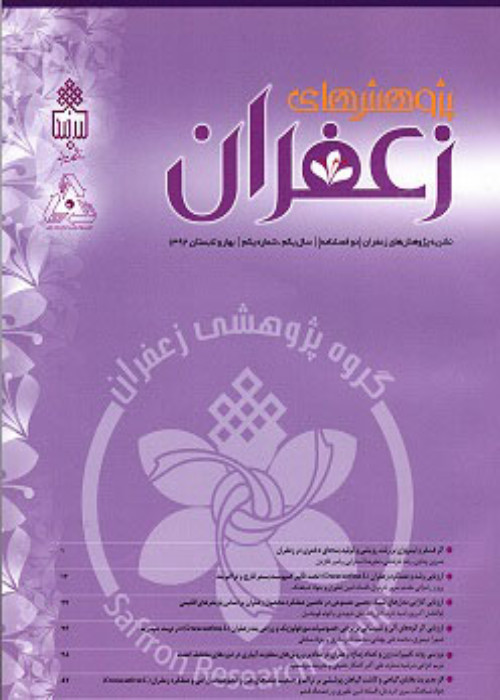Effect of Compost on Heavy Metals Changing Process and Relationship with Physiological Traits of Saffron (Crocus sativus L.)
Municipal waste compost is effective on increasing plant yield. Due to the lack of organic matter in the soils of arid and semi-arid regions, the use of organic compounds such as municipal waste compost improves the physical and chemical properties and increases the fertility of the soil (Khoshgoftarmanesh & Kalbasi, 2002). The use of municipal waste compost due to the presence of nutrients in its composition and their gradual release, which prevents the leaching and stabilization of these elements in the soil, leads to the improvement of the availability of elements for plants and direct and indirect effects on yield (Ghasraldashti et al., 2014). Therefore, the purpose of this project is to study the effect of different levels of municipal waste compost on the absorption of heavy metals in the soil and saffron plant, as well as its relationship with the flower and stigma performance of this valuable medicinal plant.
Municipal waste compost must be used more carefully. Therefore, the effects of the application of municipal waste compost on the uptake of heavy metals (Pb, Ni, Cd, and Co) in saffron plants and their relation with arable characteristics and yield of saffron were evaluated under field conditions. Treatments were four levels of municipal waste compost (0, 5, 10, and 20 t. ha-1). Before planting, different amounts of municipal waste compost were mixed with the soil to a depth of 20 cm according to the experimental plan. The first irrigation was carried out at the same time as planting (7 September 2015 as a flood), and the second irrigation was done ten days after the first irrigation to facilitate the sprouting of the tubers. Subsequent irrigations after the end of the flowering period were carried out according to the region's custom at intervals of one month and in the leakage method using a siphon. This experiment was carried out based on a randomized completely block design with three replications in the research farm of the University of Birjand, Iran, during the cropping year 2015-2016.
Results showed that municipal waste compost improved the concentration of soil Pb and Cd of saffron beside control. But, municipal waste compost has not affected significantly soil Ni and Co. The highest concentration of soil Pb and Cd (2.85 and 1.60 mg.kg-1) were obtained in plants treated with 20 t. ha-1 municipal waste compost while the lowest values were recorded in the control. Results showed that municipal waste compost improved the Pb concentration of saffron leaf besides control. The highest concentration of leaf Pb (0.68 mg.kg-1) was obtained in plants treated with 10 t. ha-1 municipal waste compost. Results showed that municipal waste compost did not significantly affect the heavy metals concentration of saffron corm and flower. The average weight of cormel, flower, and stigma yield was influenced by municipal waste compost treatments. In a study by Gholizadeh et al., (2018), by investigation the effect of municipal waste compost levels and maternal corm weight on vegetative and reproductive traits and photosynthetic indices of saffron plants, they found that the highest average fresh weight of flowers was obtained from the treatment of 20 t. ha-1 of urban waste compost with 5.06 g. m-2. Similarly, other researchers have also reported the positive effect of municipal waste compost on the yield of dry saffron stigma (Amiri, 2008). It seems that the use of municipal waste compost has increased flower yield and as a result stigma yield due to its positive effects on improving physical and chemical properties and increasing soil fertility as well as increasing the availability of nutrients by plants (Khoshgoftarmanesh & Kalbasi, 2002; Ghasraldashti et al., 2014). Therefore, considering the effect of organic treatments on the stabilization of heavy metals in the soil and reducing their absorption by plants, the use of organic materials can be a useful solution in controlling the concentration of pollutants (Karimi et al., 2012).
Based on the results of this research and according to the environmental and soil conditions of this experiment, it was determined that municipal waste compost had an effective role in increasing the corm weight and flower yield of saffron, and in this way, it was able to increase the stigma yield. Although the use of municipal waste compost in this research did not increase the concentration of heavy elements in soil and plants more than the permissible limit, due to the presence of heavy elements in municipal wastes, the necessary care should be taken in using this fertilizer in other areas so that, at the same time, using the benefits of municipal waste compost reduced the environmental risks caused by the use of compost for soil and plants.
Cormel , Heavy metals , Pb , Stigma yield
- حق عضویت دریافتی صرف حمایت از نشریات عضو و نگهداری، تکمیل و توسعه مگیران میشود.
- پرداخت حق اشتراک و دانلود مقالات اجازه بازنشر آن در سایر رسانههای چاپی و دیجیتال را به کاربر نمیدهد.



